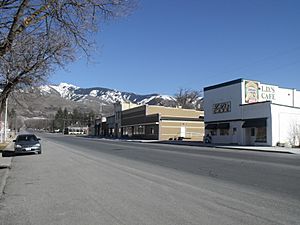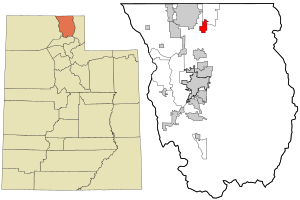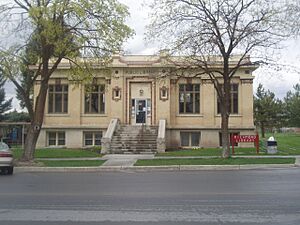Richmond, Utah facts for kids
Quick facts for kids
Richmond, Utah
|
|
|---|---|

Richmond City Main Street
|
|

Location in Cache County and the state of Utah.
|
|
| Country | United States |
| State | Utah |
| County | Cache |
| Settled | 1859 |
| Incorporated | 1868 |
| Government | |
| • Type | Mayor-Council government |
| Area | |
| • Total | 3.5 sq mi (9.06 km2) |
| • Land | 3.5 sq mi (9.06 km2) |
| • Water | 0.00 sq mi (0.00 km2) |
| Elevation | 4,652 ft (1,418 m) |
| Population
(2020)
|
|
| • Total | 2,733 |
| • Density | 811.05/sq mi (313.19/km2) |
| Time zone | UTC-7 (Mountain (MST)) |
| • Summer (DST) | UTC-6 (MDT) |
| ZIP code |
84333
|
| Area code(s) | 435 |
| FIPS code | 49-63680 |
| GNIS feature ID | 2410941 |
Richmond is a city located in Cache County, Utah, in the United States. In 2020, about 2,733 people lived there. It is part of the larger Logan metropolitan area.
Contents
History of Richmond, Utah
Richmond was first settled in the mid-1850s by Agrippa Cooper. In 1859, people exploring the area found it was a good place to live. It had plenty of water for farming and mills, and the land was fertile for growing crops.
Within a few years, settlers built simple log cabins, dugouts, and a log fort. By 1860, a sawmill and a schoolhouse were built. Many of the early settlers were Mormon pioneers, including people like Thomas Levi Whittle and Marriner W. Merrill.
How Richmond Got Its Name
The city was probably named after Charles C. Rich, an important leader in the LDS Church. He was an Apostle who helped send the first missionaries to Hawaii. Other reasons for the name might include the rich soil in the area. Also, some English settlers came from Richmond, London, which could have influenced the name.
Early Challenges and Fort Building
In 1860, Brigham Young, the President of the LDS Church, visited Richmond. He gave advice because Native Americans in the Cache Valley were sometimes unfriendly towards the settlers. Many fights had already happened. Young told the settlers to "Move your families and wagons close together." He said this would make them like a "hive of bees," ready to act if disturbed. This led the settlers to build a strong fort called "Fort Richmond."
Richmond officially became a city in 1868.
Growth and Development
In 1912, the people of Richmond voted to build a Carnegie library. The Richmond Carnegie Library was built on Main Street in 1914.
Richmond also became known for its dairy industry. In 1902, two creameries (places that make dairy products) produced a lot of milk each day. These creameries later became part of the Utah Condensed Milk Company. By 1920, they were known as Sego Milk Products. For many years, this plant was the biggest dairy operation west of the Mississippi River.
In 1962, an earthquake happened east of Richmond. It damaged many old pioneer buildings. This included the home of Marriner W. Merrill and a large LDS brick church building.
Geography and Climate
Richmond covers about 3.5 square miles (9.06 square kilometers) of land. There is no water area within the city limits.
Richmond's Climate
Richmond has a climate with big changes in temperature throughout the year. Summers are hot, and winters can be very cold. This type of climate is called a "dry-summer humid continental climate."
| Climate data for Richmond, Utah, 1991–2020 normals, extremes 1949–present | |||||||||||||
|---|---|---|---|---|---|---|---|---|---|---|---|---|---|
| Month | Jan | Feb | Mar | Apr | May | Jun | Jul | Aug | Sep | Oct | Nov | Dec | Year |
| Record high °F (°C) | 60 (16) |
66 (19) |
76 (24) |
89 (32) |
97 (36) |
101 (38) |
109 (43) |
104 (40) |
100 (38) |
88 (31) |
72 (22) |
67 (19) |
109 (43) |
| Mean maximum °F (°C) | 46.7 (8.2) |
52.2 (11.2) |
66.6 (19.2) |
76.4 (24.7) |
84.6 (29.2) |
93.0 (33.9) |
99.2 (37.3) |
97.6 (36.4) |
91.0 (32.8) |
79.6 (26.4) |
62.7 (17.1) |
50.4 (10.2) |
99.9 (37.7) |
| Mean daily maximum °F (°C) | 30.7 (−0.7) |
36.5 (2.5) |
48.8 (9.3) |
57.5 (14.2) |
67.6 (19.8) |
78.6 (25.9) |
89.3 (31.8) |
87.4 (30.8) |
76.9 (24.9) |
61.2 (16.2) |
45.0 (7.2) |
31.8 (−0.1) |
59.3 (15.2) |
| Daily mean °F (°C) | 23.7 (−4.6) |
28.3 (−2.1) |
38.9 (3.8) |
46.0 (7.8) |
54.6 (12.6) |
63.7 (17.6) |
72.7 (22.6) |
71.3 (21.8) |
61.8 (16.6) |
48.8 (9.3) |
35.8 (2.1) |
24.9 (−3.9) |
47.5 (8.6) |
| Mean daily minimum °F (°C) | 16.7 (−8.5) |
20.2 (−6.6) |
28.9 (−1.7) |
34.4 (1.3) |
41.6 (5.3) |
48.7 (9.3) |
56.2 (13.4) |
55.2 (12.9) |
46.7 (8.2) |
36.4 (2.4) |
26.6 (−3.0) |
17.9 (−7.8) |
35.8 (2.1) |
| Mean minimum °F (°C) | −2.5 (−19.2) |
1.3 (−17.1) |
13.3 (−10.4) |
22.1 (−5.5) |
28.4 (−2.0) |
36.2 (2.3) |
46.3 (7.9) |
43.5 (6.4) |
33.0 (0.6) |
21.5 (−5.8) |
8.8 (−12.9) |
−0.7 (−18.2) |
−6.4 (−21.3) |
| Record low °F (°C) | −23 (−31) |
−27 (−33) |
−7 (−22) |
12 (−11) |
20 (−7) |
29 (−2) |
36 (2) |
31 (−1) |
20 (−7) |
3 (−16) |
−20 (−29) |
−28 (−33) |
−28 (−33) |
| Average precipitation inches (mm) | 1.94 (49) |
1.82 (46) |
2.12 (54) |
2.46 (62) |
2.55 (65) |
1.40 (36) |
0.57 (14) |
0.76 (19) |
1.45 (37) |
1.80 (46) |
1.51 (38) |
1.87 (47) |
20.25 (514) |
| Average snowfall inches (cm) | 12.9 (33) |
12.7 (32) |
8.9 (23) |
4.0 (10) |
0.5 (1.3) |
0.0 (0.0) |
0.0 (0.0) |
0.0 (0.0) |
0.0 (0.0) |
1.3 (3.3) |
6.6 (17) |
15.4 (39) |
62.3 (158) |
| Average precipitation days (≥ 0.01 in) | 11.5 | 10.4 | 10.5 | 10.9 | 11.3 | 5.8 | 3.9 | 4.9 | 5.9 | 7.7 | 9.1 | 12.0 | 103.9 |
| Average snowy days (≥ 0.1 in) | 5.7 | 4.7 | 3.5 | 1.5 | 0.3 | 0.0 | 0.0 | 0.0 | 0.0 | 0.4 | 2.8 | 5.5 | 24.4 |
| Source: NOAA | |||||||||||||
People of Richmond
| Historical population | |||
|---|---|---|---|
| Census | Pop. | %± | |
| 1870 | 817 | — | |
| 1880 | 1,198 | 46.6% | |
| 1890 | 1,232 | 2.8% | |
| 1900 | 1,111 | −9.8% | |
| 1910 | 1,562 | 40.6% | |
| 1920 | 1,396 | −10.6% | |
| 1930 | 1,140 | −18.3% | |
| 1940 | 1,131 | −0.8% | |
| 1950 | 1,091 | −3.5% | |
| 1960 | 977 | −10.4% | |
| 1970 | 1,000 | 2.4% | |
| 1980 | 1,705 | 70.5% | |
| 1990 | 1,955 | 14.7% | |
| 2000 | 2,051 | 4.9% | |
| 2010 | 2,470 | 20.4% | |
| 2020 | 2,733 | 10.6% | |
In 2000, there were 2,051 people living in Richmond. Most residents were White (97.32%). About 2.49% of the population was Hispanic or Latino.
Many households (49.9%) had children under 18 living with them. Most families (73.5%) were married couples. The average household had 3.31 people.
The population was quite young, with 37.3% under 18 years old. The average age was 27 years.
Economy and Businesses
Richmond is home to several interesting businesses:
- Casper's Ice Cream: This company started in 1925. They make over 360,000 ice cream bar sandwiches every day!
- Cherry Peak Resort: A nearby place where people can go skiing.
- Lower Food's: A company that processes meat.
- Pepperidge Farm: This company opened a factory in Richmond in 1974. In 2011, they made over one million cases of Goldfish crackers. They plan to invest $160 million to upgrade their plant.
Arts and Culture
Historic Landmarks in Richmond
Richmond has many important landmarks. These include the Richmond Fort Marker, the headstone of Marriner W. Merrill, and the Richmond Veterans Memorial.
The Richmond Relief Society Hall and the Richmond Tithing Office are museums. They are run by the local Daughters of Utah Pioneers group. The Relief Society Hall is one of the oldest original Relief Society Halls still standing in Utah. Richmond has 17 buildings listed on the National Register of Historic Places. It also has over 45 local historic buildings.
You can see the hillside letters "NC" (which stand for "North Cache") on a mountain east of Richmond.
Black and White Days Festival
In 1904, Holstein Friesian cattle were brought to Richmond. They did so well that Richmond became known as Utah's Holstein center. In 1912, the first Holstein Cow Show was held.
After a disease outbreak in 1913 and 1914, the cattle show has been held every year since 1915. It is now called "Richmond's Black and White Days." This festival includes carnival rides, food, a horse pull, and a parade. It is the longest-running cattle show in the United States!
Community Groups
- In 1907, Susa Young Gates started a group of the Daughters of Utah Pioneers in Richmond. It was renamed the James and Drusilla Hendrick Camp in 2015.
- The Richmond Lions Club was formed in 1929. They still help with many community events today.
Parks and Recreation
Richmond has several places for fun and outdoor activities. These include the Richmond City Grandstand and Baseball Field, a public horse arena, an outdoor shooting range, and the Richmond Community Building.
Education in Richmond
Education in Richmond is part of the Cache School District.
- White Pine Elementary School is on the north side of Richmond.
- All 7th and 8th grade students in the northern part of the Cache School District go to North Cache Middle School.
- After middle school, students attend Sky View High School in Smithfield, Utah.
Richmond in the Media
- In 2003, parts of the movie Napoleon Dynamite were filmed at Big J's fast-food restaurant in Richmond.
- In 2006, Sue Morgan from Richmond was the first woman from Utah to compete in the Iditarod Trail Sled Dog Race. This is a very long sled dog race in Alaska.
- In 2020, a device called the Rezzimax Pain Tuner Pro, invented in Richmond, was named the "Coolest Thing Made In Utah."
Notable People from Richmond
Many interesting people have connections to Richmond:
- Herschel Bullen: A businessman, politician, and church leader.
- Dean Detton: An American professional wrestler.
- Harrison T. Groutage: An artist and professor at Utah State University.
- Paula Hawkins: A U.S. senator from Florida who went to high school in Richmond.
- William Jasper Kerr: A president of several universities and a signer of the Utah Constitution.
- Marriner W. Merrill and his son Joseph F. Merrill: Both were important leaders in The Church of Jesus Christ of Latter-day Saints.
- Joseph Monson: An architect, politician, and early settler of Richmond.
- Stillman Pond: A farmer and church leader who was an early pioneer of Richmond.
- Leroy Robertson: A musician who taught music at North Cache High School in Richmond.
- Thomas Levi Whittle: An early Mormon pioneer and settler of Richmond.
Images for kids
See also
 In Spanish: Richmond (Utah) para niños
In Spanish: Richmond (Utah) para niños





